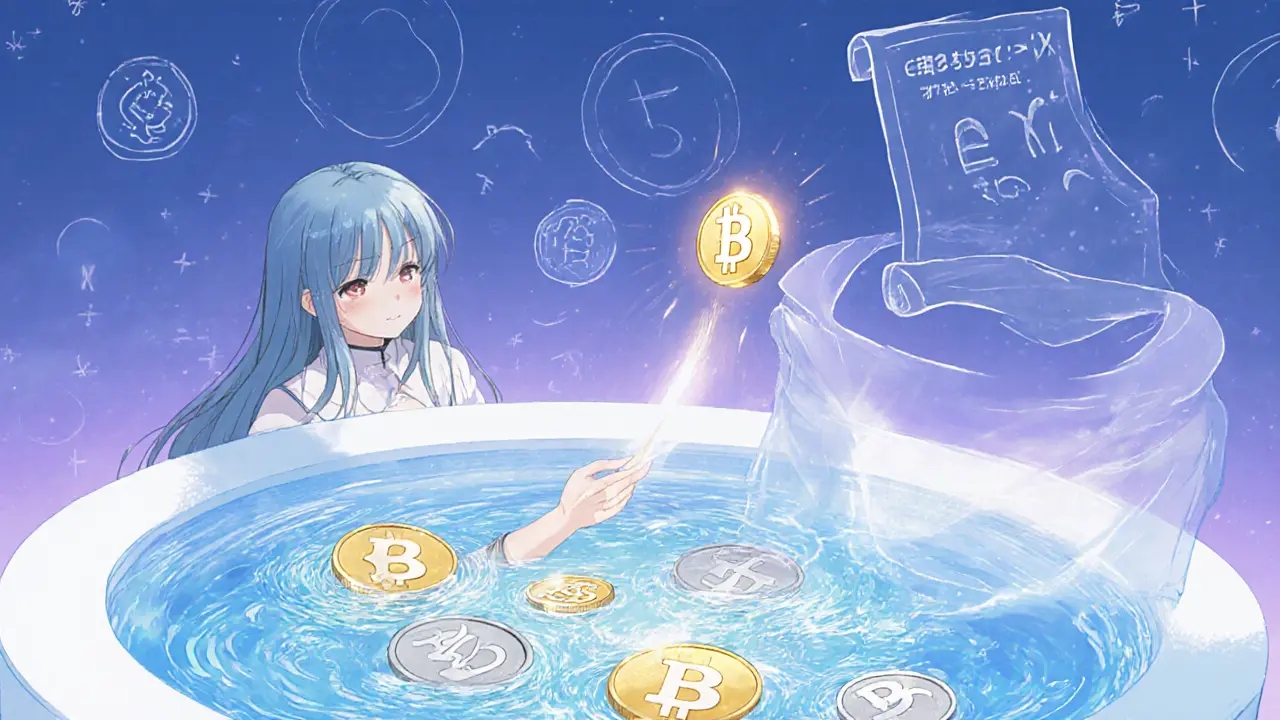Ellipsis Finance Slippage Calculator
How to Use This Calculator
Estimate your trade slippage on Ellipsis Finance based on current stablecoin pool liquidity. For best results, use a trade size under $10,000.
When you start hunting for a decentralized exchange that specializes in stablecoins, Ellipsis Finance shows up on many watchlists. Launched on the Binance Smart Chain (BSC) in April 2021, it claims to give traders ultra‑low slippage swaps, zero deposit/withdrawal fees, and a governance token that pays a share of trading fees. Below we break down how the platform works, who might benefit, where it falls short, and what the future could hold.
Key Takeaways
- Ellipsis Finance is a BSC‑based AMM built as a fork of Curve Finance, focusing solely on stablecoin pairs.
- The native token EPS migrated to EPX in 2022 with Binance backing.
- Pros: low fees, fast BSC transactions, minimal slippage, staking rewards from protocol fees.
- Cons: limited trading pairs, modest liquidity compared to larger DEXs, price volatility of the governance token.
- Ideal for traders who need cheap, reliable stablecoin swaps and investors looking for fee‑sharing staking.
What is Ellipsis Finance?
Ellipsis Finance is a decentralized exchange (DEX) that runs on Binance Smart Chain. It uses an automated market maker (AMM) model similar to Curve Finance, but the codebase is tuned for BSC’s low‑cost environment. The platform’s core promise is to let you swap stablecoins-USDT, USDC, BUSD, DAI, and others-with almost no price impact.
How Does It Work?
The protocol groups stablecoins into a single liquidity pool. When you trade, the AMM algorithm rebalances the pool to keep the price close to an external reference, which dramatically cuts slippage. Because the contracts live on BSC, typical transaction fees are a fraction of a US cent, and block times are under three seconds.
Two technical points set Ellipsis apart:
- No fees on deposits or withdrawals. You only pay the tiny BSC gas cost.
- “Impermanent loss” is effectively neutralized for stablecoins, as the pool composition stays near‑constant.
Everything runs on‑chain, so there’s no central authority that can freeze assets or change the rules without a community vote.

Token Economics: EPS and EPX
The platform’s governance token started as EPS. As of October2025, EPS trades around $0.0345 with a circulating supply of about 724million, giving a market cap near $25million. Holders can stake EPS in the protocol’s fee‑share vault and earn a proportional slice of the total trading fees collected.
In early 2022, the team launched EPX, a migrated version of EPS supported by Binance. EPX sees higher daily volume (≈$1.58million) but still struggles to break out of the $0.001-$0.004 range, according to most price‑prediction models.
Both tokens have a capped supply, so any surge in demand could theoretically push prices higher. However, the post‑launch price drop and the confusing migration have left many investors wary.
Pros and Cons
- Pros
- Fully decentralized - no custodial risk.
- Specialized for stablecoins, delivering sub‑0.01% slippage in most cases.
- Near‑zero transaction costs thanks to BSC.
- Staking EPS/EPX yields a share of protocol fees.
- Listed on CoinMarketCap, adding visibility.
- Cons
- Limited to stablecoin pairs; no major crypto‑to‑crypto pools.
- Liquidity is modest compared with Curve or PancakeSwap.
- Token price has been flat or declining since launch.
- Brand recognition lags behind older DEXs.
How Does Ellipsis Stack Up? - Comparison Table
| Feature | Ellipsis Finance | Curve Finance | PancakeSwap (Stable) |
|---|---|---|---|
| Network | Binance Smart Chain | Ethereum (Layer‑2 options) | Binance Smart Chain |
| Launch Year | 2021 | 2020 | 2020 |
| Typical Trade Fee | 0.04% (fee‑share to stakers) | 0.04% (fee‑share) | 0.25% (no fee‑share) |
| Gas Cost (average) | ~$0.001 (BSC) | ~$5‑$15 (Ethereum) | ~$0.001 (BSC) |
| Governance Token | EPS → EPX | CRV | CAKE |
| Liquidity (USD, stable pairs) | ≈$50‑$70M | ≈$3‑4B | ≈$200‑$300M |

User Experience & Staking
Getting started is simple if you already have a BSC‑compatible wallet like MetaMask, Trust Wallet, or Binance Chain Wallet. Here’s a quick flow:
- Connect your wallet to the Ellipsis Finance website.
- Swap any supported stablecoin (e.g., USDT → USDC). The UI shows estimated slippage; most trades stay under 0.02%.
- To earn fees, go to the “Stake” tab, approve EPS/EPX, and lock the amount you want. Rewards are auto‑compounded daily.
- Monitor your earnings on the dashboard; you can withdraw anytime without penalty.
Users appreciate the low gas and quick confirmations, but many complain about the narrow pool selection. If you want to trade a non‑stable token, you’ll need to hop to a different DEX.
Risk Considerations & Price Outlook
Like any DeFi project, Ellipsis carries smart‑contract risk. Though the code was audited during the Ellipsis2.0 upgrade, a bug could still expose funds. The platform’s reliance on BSC also means it inherits Binance’s regulatory and technical considerations.
Token price forecasts are wildly split. Most analysts peg EPS/EPX between $0.03‑$0.04 for 2025, while a few optimistic models see jumps into the $0.10‑$0.20 range if liquidity improves. The consensus cautions that price predictions are speculative; investors should only allocate what they can afford to lose.
A key determinant will be whether Ellipsis can expand beyond stablecoins without sacrificing its low‑slippage edge. New pools for algorithmic stablecoins or cross‑chain assets could boost volume and token demand.
How to Start Using Ellipsis Finance
- Set up a BSC wallet. Install MetaMask, switch the network to Binance Smart Chain (RPC: https://bsc-dataseed.binance.org/).
- Buy BNB. You’ll need a small amount for gas; purchase on any major exchange and transfer to your wallet.
- Visit the official site. Click “Connect Wallet” and approve the connection.
- Select a stablecoin pair. Enter the amount, check the slippage tolerance (default 0.5% is safe), then confirm.
- Stake EPS/EPX. Navigate to the staking page, approve the token, choose how much to lock, and confirm. Rewards appear in the “Earned” column.
- Track performance. Use BSCScan or DEX analytics dashboards to watch pool depth and token price.
That’s it-no KYC, no order books, just a few clicks and you’re trading stablecoins on a decentralized network.
Frequently Asked Questions
Is Ellipsis Finance safe to use?
The platform runs on audited smart contracts and has no custodial control, which reduces many traditional risks. However, as with any DeFi app, smart‑contract bugs or network attacks are possible. Users should start with small amounts and keep their private keys secure.
How does staking EPS earn me money?
When you lock EPS or EPX in the fee‑share vault, the protocol distributes a slice of all trading fees collected from the stablecoin pools. The reward is proportional to your stake and compounds automatically.
Can I trade non‑stablecoins on Ellipsis?
Currently the protocol only supports stablecoin pairs. For other assets you’ll need a different DEX like PancakeSwap or UniSwap.
What’s the difference between EPS and EPX?
EPS was the original governance token. In 2022 the project migrated to EPX, a Binance‑supported version with a new contract address. Both serve the same purpose-governance and fee sharing-but EPX has slightly higher daily volume due to the migration.
Do I need BNB to trade on Ellipsis?
Yes, BNB is the native gas token for BSC, so you’ll need a small amount to cover transaction fees. The cost is usually less than a cent per swap.
If you’re after a cheap, fast way to move stablecoins without a centralized order book, Ellipsis Finance review shows a platform that delivers on that promise but still needs broader liquidity and token price momentum. Do your own research, start small, and keep an eye on upcoming upgrades before committing large sums.


VEL MURUGAN
Ellipsis Finance does deliver the ultra‑low slippage it promises, but the EPS/EPX token price has been as flat as a pancake for months, which makes the fee‑sharing incentive less compelling for long‑term holders.
Russel Sayson
Let’s break this down step by step. First, the platform’s architecture on BSC gives it a gas‑cost advantage that no one can ignore, especially when you’re swapping $10,000 worth of USDT for USDC and the fee is literally a fraction of a cent. Second, the AMM algorithm is essentially a fork of Curve, meaning the price impact stays under 0.02% for standard stablecoin trades, which is remarkable for a relatively young protocol. Third, the fee‑share model channels a portion of trading fees back to EPS/EPX stakers, creating a modest yet steady yield that compounds automatically. Fourth, the token migration to EPX, backed by Binance, adds a layer of institutional confidence, even though the market price remains stubbornly low. Fifth, security audits were performed during the Ellipsis 2.0 upgrade, but no code is ever immune to hidden bugs, so a cautious allocation is prudent. Sixth, the liquidity, while respectable at $50‑70 M, still lags far behind giants like Curve, which means large trades could still see slippage spikes beyond the advertised sub‑0.01% range. Seventh, the token’s capped supply means any future demand surge could push the price upward, but only if the ecosystem expands beyond stablecoins. Eighth, community governance is fully on‑chain, so any major parameter changes require token holder votes, preserving decentralization. Ninth, the user experience is streamlined: connect your wallet, choose a pair, and confirm – no KYC, no hidden steps. Tenth, the staking dashboard is intuitive, showing real‑time rewards without heavy analytics. Eleventh, the absence of non‑stable pairs keeps the platform niche but also limits its appeal to broader traders. Twelfth, the platform’s reliance on Binance Smart Chain ties its fate to Binance’s regulatory posture, which could become a risk factor. Thirteenth, the roadmap hints at cross‑chain stablecoin bridges, which could dramatically boost volume if delivered. Fourteenth, the token’s flat price may simply reflect market saturation, not a fundamental flaw. Fifteenth, for risk‑averse users, the combination of low fees, rapid swaps, and modest yields makes Ellipsis a viable tool in a diversified DeFi strategy. In summary, the platform shines in its specialization but must grow its liquidity and token utility to truly compete.
Isabelle Graf
If you think Ellipsis will magically solve all your profit problems, think again.
Millsaps Crista
Look, the low‑fee environment is great for day traders who need speed, but don’t expect the governance token to skyrocket overnight. The staking rewards are decent, yet they’re directly tied to trading volume, so if the platform doesn’t attract more users, those yields will plateau. Also, the UI is clean and intuitive – you won’t get lost trying to find the ‘Stake’ tab. Finally, keep in mind that BSC’s centralization concerns could affect long‑term sustainability, so stay diversified.
Matthew Homewood
From a philosophical standpoint, the trade‑off between decentralization and efficiency is embodied in Ellipsis. It sacrifices some breadth of assets for razor‑thin slippage on stable pairs. The question is whether that specialization justifies the modest token economics.
EDMOND FAILL
Just poked around the UI and the slippage estimator seems spot on for small trades. I like that you can just pop in an amount and see the numbers instantly. The gas cost is practically nothing, which is a sweet deal for regular swaps.
Jennifer Bursey
Ellipsis is a classic case of niche‑crafting in the DeFi ecosystem – it zeroes in on stablecoin arbitrage, leveraging BSC’s throughput to deliver sub‑basis‑point spreads. The fee‑share vault essentially tokenizes protocol revenue, creating a quasi‑passive income stream for EPS/EPX holders. However, the liquidity caps mean you’ll hit diminishing returns on larger orders, so diversification across pools remains essential. In short, it’s a solid engine for low‑slippage swaps but doesn’t replace a full‑scale DEX for broader asset exposure.
Maureen Ruiz-Sundstrom
The whole EPS to EPX migration feels like a staged marketing ploy rather than a genuine upgrade. Tokenomics are tidy on paper, yet the market reaction has been tepid at best. If you’re looking for real yield, you might be better off staking on more established platforms.
Kevin Duffy
Really impressed with how cheap the swaps are – I’m swapping $5k daily and the gas is practically invisible! 😎 Keep the good vibes rolling, Ellipsis!
Tayla Williams
While I appreciate the elegance of the design, I must point out several grammatical inacceleracies within the documentation, which could potentially mislead novice users. Moreover, the overall experience could benefit from a more robust audit presence. Kindly address these concerns forthwith.
Brian Elliot
For newcomers, the step‑by‑step guide is quite helpful. Remember to keep a small BNB reserve for gas to avoid transaction hiccups. Also, monitor the fee‑share vault regularly to gauge reward performance. Diversifying across multiple stablecoin pools can further mitigate risk.
Marques Validus
Wow the hype around Ellipsis is totally overblown it's just another stable swap dEX you can get the same thing on curve but cheaper sure but why all the drama it's like people think they've discovered the holy grail of finance when it's just a niche tool for low‑slippage trades
Mitch Graci
Oh great another “decentralized” platform that pretends to be independent while sitting on Binance’s shoulders!!! 😤🇺🇸